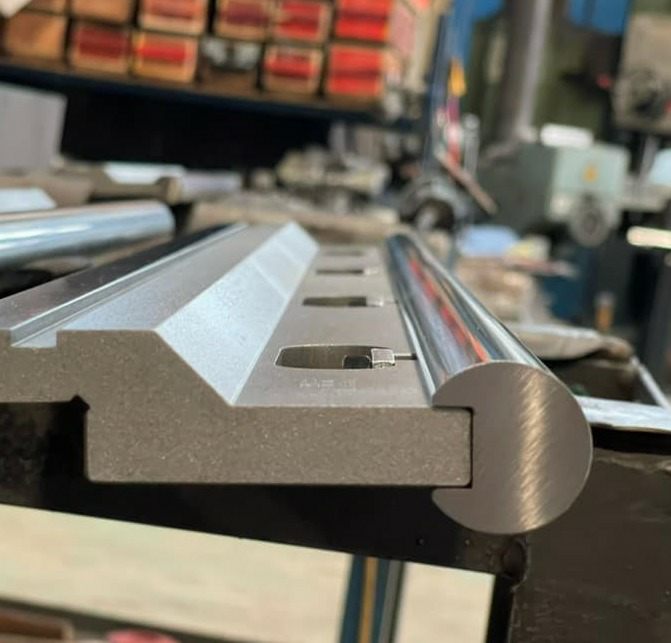In the metal processing industry, the durability of press brake tooling directly impacts production efficiency, product quality, and overall cost control. For factories and manufacturers, improving press brake tooling durability not only reduces costs related to frequent tool replacements but also greatly enhances production continuity and stability. This article will examine the factors affecting tool lifespan and provide five practical methods to extend Press brake dies life, helping you control costs effectively and increase your company’s competitiveness.
1. Why Tooling Durability Matters
As a critical component of the press brake machine, tooling often operates in high-stress, continuous-use environments. With prolonged usage, tooling may experience wear, chipping, or even cracking, which can cause machine downtime and lead to production delays. These issues not only disrupt delivery schedules but also significantly raise operational costs. Therefore, increasing tooling durability can help businesses reduce tooling wear and lower replacement frequency while also enhancing equipment reliability.
2. Key Factors Affecting the Durability of Press Brake Tooling
To effectively extend the lifespan of Press brake dies, it’s essential to understand how various factors impact its durability. By analyzing these critical factors, businesses can identify the primary areas for improvement and develop targeted strategies. Here are the four main factors that influence tooling durability:
- Material Quality: The quality of tooling materials determines their durability in high-stress environments. Generally, low-quality materials accelerate tool wear and increase replacement frequency. Statistics show that tooling made from standard steel typically withstands 2,000 to 3,000 bending operations, while high-strength alloy tooling endures 5,000 to 10,000 operations. Therefore, selecting high-hardness, high-wear-resistance materials, such as high-strength steel or tungsten steel, can significantly extend tooling lifespan.
- Operational Factors: Operational details directly impact tooling life. Studies indicate that up to 40% of tooling damage stems from improper operation. For example, if operators fail to adjust pressure and angle settings according to workpiece material, tooling is subjected to unnecessary stress, accelerating wear. Standardizing operational procedures and regularly training employees can help reduce tool wear due to misuse.
- Tooling Design: Stress concentration in tooling design is a common cause of premature wear. If tooling design is inadequate, especially at bends or stress points, cracks or chipping may occur. Data show that optimized tooling can last 25% to 35% longer than unoptimized tooling. Thus, factoring stress distribution into the design phase is crucial for extending tooling life.
- Workpiece Material: Different workpiece materials affect tooling wear to varying degrees. For instance, high-hardness metals, like stainless steel or titanium alloys, cause more wear than standard carbon steel. Studies indicate that tooling wears twice as fast when processing titanium compared to ordinary carbon steel. Choosing wear-resistant materials for tooling and setting parameters suited to specific workpieces can substantially extend tooling life.
3. Five Practical Methods to Increase Press Brake Tooling Durability
Based on these factors affecting tooling durability, we outline five practical methods to help businesses extend tooling life and reduce production costs.
1. Regular Inspection and Maintenance
Regular inspections and maintenance form the foundation for prolonging tooling lifespan. Routine maintenance—such as surface cleaning, lubrication, and regular inspections—effectively prevents wear and damage. In practice, these essential maintenance steps can result in 15% to 25% longer tooling life.
- Surface Cleaning: Over time, tooling accumulates oil, dust, and other contaminants that can create frictional layers on the tooling surface, causing additional wear. Industry data shows that regular surface cleaning can reduce wear by 10% to 15%.
- Lubrication: Applying proper lubricants can reduce friction in tool contact areas. For tooling in long-term operation, lubrication substantially decreases friction, thus extending lifespan. Statistics show that adding the right lubricant can reduce wear by 20%.
- Inspection Frequency: It’s recommended to inspect tooling every 500 hours of work or once a month, based on production intensity and actual use. Research shows that regular inspection and timely repair of minor cracks or wear can extend tooling life by 15% to 20%.
2. Use High-Quality Materials for Tooling
The choice of tooling materials has a direct impact on lifespan. High-quality materials significantly reduce wear and the likelihood of chipping, enhancing tooling durability.
- High-Strength Steel: For processing high-hardness workpieces, high-strength steel such as SKD11 is ideal for Bending dies. Data analysis reveals that tooling made from high-strength steel lasts 30% to 50% longer than standard steel tooling.
- Special Alloys: Materials like tungsten or cobalt alloy have excellent wear resistance and impact resistance, making them suitable for high-intensity use. Test data shows that tungsten tooling lasts over 60% longer than standard tooling. For high-demand bending operations, selecting high-durability alloy materials is undoubtedly the best choice.
3. Precise Adjustment of Press Brake Parameters
Precisely adjusting press brake parameters during operation is essential to reduce tool wear and extend its life. Proper control of pressure, speed, and angle significantly reduces wear and stress concentration on tooling.
- Pressure Control: Excessive pressure causes uneven surface stress, leading to cracks or damage. Experiments show that every 10% increase in pressure reduces tooling life by 5% to 8%. Avoiding overloading can greatly reduce wear.
- Angle Setting: Setting the correct bending angle reduces unnecessary stress at the bending points. Studies indicate that optimizing angle settings can reduce tool wear by 10% to 15%.
- Speed Adjustment: Lowering speed during high-stress operations reduces heat and surface friction wear. For extended operations, it’s recommended to reduce bending speed. Trials indicate this can cut wear by 12%.
4. Optimize Tooling Design
Tooling design significantly affects durability. Optimizing the design reduces stress concentration points and extends tooling life.
- Stress Concentration: Tooling design should avoid sharp corners and sudden turns, as these stress-concentrated areas easily lead to surface cracking. Redesigning sharp angles into rounded shapes can extend tooling life by 20%.
- Heat Dissipation Design: For tooling used in high-temperature conditions, adding heat-dissipation features can significantly lower heat buildup, reducing the risk of material fatigue. Testing shows that heat-resistant tooling designs increase lifespan by an average of 25%.
5. Choose a Professional Supplier
A high-quality tooling supplier can provide reliable products and comprehensive after-sales support.
- Supplier Quality Assurance: Data shows that choosing reputable suppliers reduces tooling damage rates by 30%, as these suppliers follow strict material selection and manufacturing standards.
- Technical Support: A reliable supplier offers installation, usage, and maintenance guidance, reducing user errors and extending tooling life.
4. Case Study: Success in Increasing Tooling Durability
To better illustrate the benefits of increasing press brake tooling durability, here’s a real-life example:
A metal processing company faced rising costs due to frequent tooling replacements. By implementing changes in tooling materials, adjusting operating parameters, and selecting high-quality suppliers, they successfully extended their tooling life from two to six months. This reduced the replacement frequency by 50% and saved substantial operational costs. This approach not only increased production efficiency but also strengthened the company’s competitive edge in the market.
5. Long-Term Benefits of Improving Press Brake Tooling Durability
Enhancing press brake tools durability is not only essential for cost reduction but also offers a competitive edge and higher production efficiency for businesses. Here are the main benefits:
- Cost Savings: By extending tooling life, businesses can greatly reduce replacement frequency. A medium-sized factory that uses 200 tools annually could save up to $40,000 per year if average tool life increases by 50%.
- Increased Production Efficiency: More durable tooling minimizes production line downtime, allowing factories to complete orders more efficiently. For a factory with an annual output of 10,000 units, a 20% increase in tooling life can boost production efficiency by approximately 15%, shortening delivery time and improving customer satisfaction.
- Enhanced Competitiveness: Highly durable tooling provides stable production support, helping businesses build a solid reputation. In a competitive manufacturing market, stable production and consistent product quality help companies secure more orders and customer loyalty.
In summary, optimizing Metal bending dies durability is a valuable investment with multiple advantages. It helps companies save operational costs and boosts market competitiveness. The methods and data shared here offer practical guidance for tooling management, helping companies maximize efficiency in production.
6. Conclusion: Take Action to Extend Press Brake Tooling Life
In conclusion, extending the life of press brake punch and die requires a comprehensive approach that considers material selection, parameter settings, routine maintenance, and supplier choice. By applying scientifically optimized methods, companies can greatly improve tooling durability, effectively reduce replacement frequency, and save costs. We hope this guide helps you find suitable solutions, driving your business toward greater efficiency and sustainability.
If you have any questions about tooling lifespan improvement, feel free to contact us. Our team of experts is dedicated to providing technical support and guidance, helping you increase equipment durability and maximize production benefits!






4 Responses